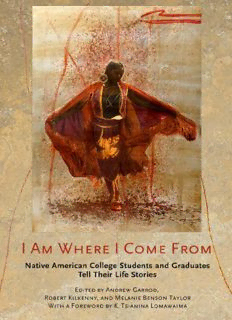
I Am Where I Come From: Native American College Students and Graduates Tell Their Life Stories PDF
Preview I Am Where I Come From: Native American College Students and Graduates Tell Their Life Stories
I AM WHERE I COME FROM I AM WHERE I COME FROM Native American College Students and Graduates Tell Their Life Stories EDITED BY Andrew Garrod, Robert Kilkenny, and Melanie Benson Taylor WITH A FOREWORD BY K. Tsianina Lomawaima Cornell University Press Ithaca and London Cover illustration: Celestial #2 (Shannon Prince), from the Dartmouth Pow-Wow Suite, 2009, by Mateo Romero (Cochiti Pueblo). Photo transfer and acrylic paint on 60 x 40 in panel. Courtesy of the Hood Museum of Art, Dartmouth College, Hanover, New Hampshire; purchased through the Mrs. Harvey P. Hood W'18 Fund. Copyright © 2017 by Cornell University All rights reserved. Except for brief quotations in a review, this book, or parts thereof, must not be reproduced in any form without permission in writing from the publisher. For information, address Cornell University Press, Sage House, 512 East State Street, Ithaca, New York 14850. First published 2017 by Cornell University Press First printing, Cornell Paperbacks, 2017 Printed in the United States of America Library of Congress Cataloging-in-Publication Data Names: Garrod, Andrew, 1937– editor. | Kilkenny, Robert, editor. | Taylor, Melanie Benson, 1976– editor. | Container of (work): Prince, Shannon. Seeking to be whole. Title: I am where I come from : Native American college students and graduates tell their life stories / edited by Andrew Garrod, Robert Kilkenny, and Melanie Benson Taylor. Other titles: First person, first peoples. Description: Ithaca : Cornell University Press, 2017. | “The essays by N. Bruce Duthu, Davina Two Bears, and Bob Bennett originally appeared in the 1997 book, First Person, First Peoples: Native American College Graduates Tell Their Life Stories”—Foreword. | Includes bibliographical references. Identifiers: LCCN 2016049570 (print) | LCCN 2016050595 (ebook) | ISBN 9781501706912 (cloth : alk. paper) | ISBN 9781501706929 (pbk. : alk. paper) | ISBN 9781501708015 (epub/mobi) | ISBN 9781501708022 (pdf) Subjects: LCSH: Indians of North America—Education (Higher)—New Hampshire—Hanover. | Indian college students—New Hampshire—Hanover—Biography. | Minority college graduates—New Hampshire—Hanover— Biography. | Dartmouth College—Students—Biography. Classification: LCC E97.65.N4 I24 2017 (print) | LCC E97.65.N4 (ebook) | DDC 378.1/9829707423—dc23 LC record available at https://lccn.loc.gov/2016049570 Cornell University Press strives to use environmentally responsible suppliers and materials to the fullest extent possible in the publishing of its books. Such materials include vegetable-based, low-VOC inks and acid-free papers that are recycled, totally chlorine-free, or partly composed of nonwood fibers. For further information, visit our website at www.cornellpress.cornell.edu. This book is dedicated to the Native students who have opened their lives with such generosity and grace and to the many others whose stories have yet to be told. And to former Native students, friends, and teachers at Dartmouth and in the Marshall Islands: Taylor Keen Melissa Candelaria Carnell Chosa Diandra Benally Saige Hoaglin Cody Riggers Casey Sovo Paige Anderson Peter Sabori Sarah McGlaughlin Casey Lozar Nehomah Thundercloud Colleen Larimore Carmen Lopez Eric Hogenson Cheryl Two Bears Jacqueline Begay Hannah Sahn Gilbert Littlewolf Dwight Bero Kodiak Burke Cote Theriault Aaluk Edwardson Aza Erdrich Shawn Attakai Don Carlos Steele Amado Sainz Shawn Schmitt Andre Cramblit AG Contents Foreword K. Tsianina Lomawaima ix Preface xiii Introduction: Coming Home Melanie Benson Taylor 1 PART I. BROKEN: RACIAL MIXTURE AND CULTURAL HYBRIDITY 1. Seeking to Be Whole Shannon Joyce Prince 19 2. Bringing Back a Piece of the Sky Blythe George 36 3. Chahta hattak sia, “I Am a Choctaw Man” Preston Wells 52 PART II. AN INDIAN EDUCATION: LEAVING AND FINDING HOME AT DARTMOUTH COLLEGE 4. Nihalgai Bahane’, A Fourth-World Story Jerry Watchman 69 5. Bracelets Upon My Soul Ma’Ko’Quah Jones 85 6. My Journey to Healing Kalina Newmark 100 viii Contents PART III. FULL CIRCLE: RETURNING AND REMAKING HOME 7. Little Woman from Lame Deer Cinnamon Spear 117 8. Village Girl AlexAnna Salmon 137 9. Future Ancestor Hilary Abe 151 10. An Unpredictable Journey John Around Him 172 PART IV. CONTINUING EDUCATION: NADS REFLECT ON THEIR JOURNEYS 11. I Walk in Beauty Davina Ruth Begaye Two Bears 191 12. The Good Ol’ Days When Times Were Bad N. B ruce Duthu 219 13. Why Didn’t You Teach Me? Bob Bennett 243 Notes 273 About the Editors and Author of the Foreword 277 Foreword In his haunting, searingly beautiful memoir of early twentieth-century student life at St. Peter Claver’s Indian Residential School—known to its captive boys as “Spanish”—Ojibwa educator and language scholar Basil Johnston wrote of shame, laughter, desolation, rebellion, camara- derie, and, eventually, escape. He concluded by quoting his friend Dom- inic: “We toughed it out, didn’t we? They couldn’t break us down, could they?” 1 When I interviewed my dad, Curtis Thorpe Carr (Creek) and about fifty other alumni of the Chilocco Indian Agricultural School, their memories of Indian school in the 1920s and 1930s—like Johnston’s— mingled anger, joy, nostalgia, and anguish. 2 Bitter recollection inter- twined with fond remembrance, as survivors of Canadian residential and US boarding schools made meaning of their lives. That is not to say that the institutions themselves were balanced, or equitable, or humane. They were not. They were schools that took schooling to extremes, and in the blast furnace of colonialism welded the worst aspects of schooling— rigidity, homogenization, abuse of power, mindless bureaucracy, demean- ing labor, and rote “learning”—with racism, oppression, and dispossession to eliminate the Native. 3 They destroyed some, wounded others, but also forged resilient survivors. The experiences, then, of Native peoples with colonial schools are diverse, complex, and filled with paradox. We must not forget: for Na- tive peoples, most schools still are colonial. That’s true in 2017, and well beyond, most likely. Indigenous self-determination in education has deep—centuries-deep—roots; but the beginnings of Indigenous self- determination in schooling in the United States date back only to the
Description: